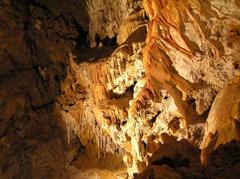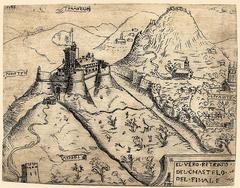Ponte delle Fate Visiting Hours, Tickets, and Guide to Finale Ligure Historical Sites
Date: 14/06/2025
Introduction: The Significance of Ponte delle Fate
Nestled in the evocative Val Ponci near Finale Ligure, Italy, Ponte delle Fate—known as the “Bridge of the Fairies”—is a remarkable relic of Roman engineering and a focal point of Liguria’s cultural heritage. Dating to the early Imperial period (1st–2nd century CE), the bridge embodies the technical mastery of Roman builders, featuring a semi-circular arch and opus quadratum masonry crafted from locally quarried limestone. Strategically situated along the Via Julia Augusta, an essential Roman artery connecting the Ligurian coast with Gaul, Ponte delle Fate was vital for trade, military movements, and communication throughout the Empire.
Layered with local legend and surrounded by the lush, geologically fascinating Val Ponci, the bridge is not only an archaeological treasure but also a symbol of the interplay between history and nature. The entire valley, dubbed the “Valley of the Bridges,” offers visitors a living museum of Roman infrastructure, ancient quarries, and prehistoric sites, all accessible via scenic hiking trails from nearby villages such as Verzi.
Open year-round and free to access, Ponte delle Fate appeals to history enthusiasts, outdoor adventurers, and families alike. Educational programs and archeotrekking tours, organized by institutions like the Museo Archeologico del Finale, further enrich the visitor experience by providing expert insights and historical context.
Whether your interests lie in exploring ancient engineering, discovering Ligurian folklore, or simply immersing yourself in Mediterranean landscapes, Ponte delle Fate offers an unforgettable journey through time. For detailed visitor information, refer to resources such as the Museo Diffuso del Finale, Visit Finale Ligure, and Romano Impero.
Article Contents
- Historical Background
- Etymology and Cultural Legacy
- Roman Engineering: Construction Techniques and Materials
- Strategic Importance in the Roman Road Network
- Archaeological Discovery and Preservation
- Visitor Information: Hours, Tickets, Access, and Tips
- Travel Recommendations and Nearby Attractions
- Val Ponci Visiting Guide: Roman Bridges and Trails
- Guided Tours and Responsible Tourism
- FAQs
- Visual and Interactive Media
- Conclusion and Further Reading
Historical Background: Roman Finale Ligure
Finale Ligure has long been a crossroads of cultures and commerce, with evidence of settlement stretching back to prehistory (Outdooractive). During the Roman era, the region’s strategic position along the Ligurian coast made it a linchpin for connecting the Italian peninsula to southern France and beyond. The construction of the Via Julia Augusta under Augustus in the late 1st century BCE established Finale Ligure as a key node in the Roman transportation and communication network, with bridges like Ponte delle Fate ensuring continuity across the region’s challenging topography.
Etymology and Cultural Legacy
The name “Ponte delle Fate”—“Bridge of the Fairies”—reflects the site’s deep roots in local folklore. While its origins are Roman, legends of supernatural guardians have flourished, blending myth with history. The bridge’s enduring presence in local storytelling underscores its significance as both a functional structure and a symbol of regional identity.
Modern hiking and cycling routes, many of which follow ancient paths, continue to integrate the bridge into contemporary local life, highlighting the adaptability and resilience of Roman infrastructure.
Roman Engineering: Construction Techniques and Materials
Constructed using opus quadratum—large, finely cut limestone blocks placed without mortar—Ponte delle Fate exemplifies Roman engineering adapted to the Ligurian landscape. The bridge features a single, semi-circular arch of wedge-shaped voussoirs, its keystone locking the structure and efficiently distributing weight. The abutments are deeply anchored into the rocky banks, providing stability against water flow and erosion (Romano Impero).
Despite its modest dimensions (approx. 10–15 meters long by 3–4 meters wide), the bridge demonstrates the Romans’ capacity to harmonize utility and durability with the surrounding environment.
Strategic Importance in the Roman Road Network
Ponte delle Fate was integral to the operation of the Via Julia Augusta and its offshoots, enabling uninterrupted travel and commerce across Liguria. While direct inscriptions have not been found at the bridge, its alignment and construction are consistent with documented Roman roads and milestones in the area. The broader network facilitated not only military logistics but also the movement of goods and cultural exchange.
Archaeological Discovery and Preservation
Archaeological surveys and finds—including pottery, coins, and road fragments—attest to the bridge’s Roman origins and the valley’s long-term occupation (Outdooractive). Conservation efforts have stabilized the bridge and protected it as a cultural asset, with digital documentation supporting ongoing preservation.
The site forms part of the Museo Diffuso del Finale, an open-air museum concept that integrates archaeological sites and trails throughout the region.
Visitor Information: Hours, Tickets, Access, and Tips
- Location: Accessible via marked hiking trails from Verzi (parking available), Ponte delle Fate is a 30–45-minute moderate walk through Val Ponci.
- Visiting Hours: Open-air and accessible year-round during daylight hours; no official opening/closing times.
- Tickets: Entry is free. Guided tours and special events may require advance booking and a fee.
- Guided Tours: Offered periodically by the Museo Archeologico del Finale and local outfits. Tours may include English-language options; advance reservations are advised (Visit Finale Ligure).
- What to Bring: Sturdy shoes, water, snacks, sun protection, and a camera. Trails are natural and can be rocky or slippery in wet weather.
- Accessibility: The route is not wheelchair accessible; visitors should expect uneven ground.
- Site Conduct: Climbing on the bridge, removing stones, or leaving litter is prohibited. Dogs are permitted on a leash; cyclists should not ride across the bridge itself.
Travel Recommendations and Nearby Attractions
- Best Seasons: Spring and autumn offer the most pleasant conditions and vibrant scenery.
- Finalborgo: A nearby medieval village with dining, shopping, and the Museo Archeologico del Finale.
- Baia dei Saraceni: A beautiful beach for swimming and relaxation.
- Castel Gavone: Medieval ruins accessible by local hiking trails.
- Local Cuisine: Enjoy Ligurian specialties in Finale Ligure’s trattorias.
Val Ponci Visiting Guide: Roman Bridges and Trails
Geological and Environmental Features
Val Ponci is a “fossil valley” shaped by millennia of geological activity, lined with Miocene limestone and Mediterranean flora (mudifinale.com). Its dramatic rock formations and “giant’s kettles” offer a striking natural backdrop to the archaeological remains.
Archaeological Highlights
The valley preserves five Roman bridges, of which Ponte delle Fate is the best preserved and walkable. Others include Ponte Sordo, Ponte delle Voze, Ponte dell’Acqua, and the nearly vanished Ponte di Magnone (mudifinale.com). The Roman quarries between Ponte delle Voze and Ponte dell’Acqua reveal ancient stone extraction methods.
Trails and Access
- Main trail: approx. 2 km each way, suitable for most walkers and mountain bikers (outdooractive.com).
- Trailheads: Primary access from Verzi; alternative routes from Magnone/San Giacomo.
- Facilities: Limited parking; no on-site toilets or refreshment stands.
Guided Tours and Education
The Museo Archeologico del Finale offers guided archeotrekking tours, with interpretive panels along the route and occasional educational workshops.
Responsible Tourism
Visitors are urged to remain on marked trails, avoid picking plants or disturbing wildlife, and heed fire safety rules—especially in summer (finaleoutdoor.com).
FAQs
Q: Do I need tickets to visit Ponte delle Fate or Val Ponci?
A: No, both are open-air sites with free access. Guided tours may charge a fee.
Q: What are the best times to visit?
A: Spring and autumn for mild weather and lush scenery; early morning or late afternoon in summer.
Q: Is the site suitable for children or people with mobility challenges?
A: Trails are moderate but uneven; suitable for families with older children. Not wheelchair accessible.
Q: Are pets allowed?
A: Yes, on a leash.
Q: Are there guided tours?
A: Yes, via the Museo Archeologico del Finale and local operators.
Q: What other sites are nearby?
A: Finalborgo (medieval village), Baia dei Saraceni (beach), Castel Gavone (castle ruins), and prehistoric caves.
Visual and Interactive Media
- Explore virtual tours and event updates at the Museo Diffuso del Finale Official Site.
- Access hiking maps and visitor info at the Finale Ligure Tourism Board.
- Enjoy photo galleries and interactive maps illustrating the bridges and trails.
Alt text for visuals: “Ponte delle Fate Roman bridge in Finale Ligure surrounded by Mediterranean vegetation”; “Map of Val Ponci hiking trails and Roman archaeological sites.”
Conclusion
Ponte delle Fate is an outstanding example of Roman engineering set within the enchanting landscape of Val Ponci. Its historical significance, coupled with accessible trails and vibrant local culture, make it an essential destination for travelers seeking to experience Liguria’s layered past. By respecting conservation guidelines and engaging with guided tours, visitors help preserve this unique heritage for future generations.
For more information on planning your visit, consult Visit Finale Ligure, Museo Diffuso del Finale, and Romano Impero. Enhance your exploration with the Audiala app and stay connected for updates on events, tours, and new discoveries across Finale Ligure.

